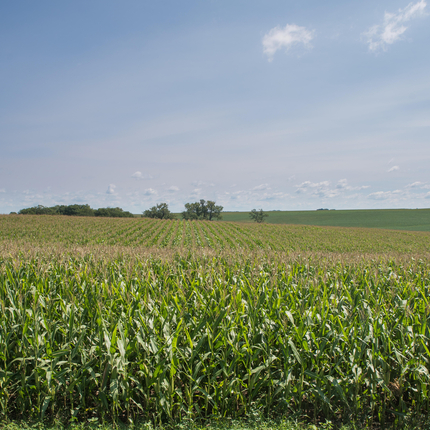By Nick Summers, former staff member
Kayla Bergman, senior policy associate for the Center for Rural Affairs, joined members of the RE-AMP Network’s Agriculture Hub Project Team, in releasing a report focused on the nexus of climate change and agriculture in the Midwest.
“Transforming Agriculture in the Midwest” analyzes the current state of the industry in the region and develops an understanding of what potential actions can be taken to reduce emissions from agriculture and food systems.
The report looks at how the nine states that make up the RE-AMP Network—Illinois, Iowa, Kansas, Michigan, Minnesota, Ohio, North Dakota, South Dakota, and Wisconsin—are responsible for 42% of agricultural greenhouse gas emissions in the U.S.
These emissions contribute to climate change, which in turn, have a direct effect on the quality of life and the economies of rural communities. Altered weather patterns means the potential for increased flooding, droughts, and severe storms, which could reduce crop yields and livestock productivity. These effects will also drive up the cost of food, increasing costs for rural residents at the same time as it reduces their income.
The broad actions the report identifies as ways to reduce these emissions and build more sustainable agriculture and food systems are addressing historical inequities in our systems, revitalizing rural communities affected by the trend toward larger, highly mechanized farms, global supply chains, and foreign ownership of farmland, and improving ecosystem services.
The specific strategies promoted in the report include encouraging reductions in fertilizers, pesticides, synthetic chemicals, and mechanized tilling, promoting on farm conservation practices, participation in and the growth and development of federal conservation programs, and use of agrivoltaics. The report also encourages continued advocacy for federal legislation that helps farmers reduce emissions and sequester carbon, such as the Growing Climate Solutions Act and the next farm bill.
These strategies would increase the on-farm ability to sequester carbon in the soil. According to the report, if half of the potential acres in these nine states are farmed with techniques that sequester carbon, that would result in approximately 17 million tons of carbon sequestered or the equivalent of removing 3.3 million cars off the road annually. Other benefits include protecting valuable topsoil, improving soil health, enhancing water quality, restoring biodiversity and increasing wildlife, producing higher-quality, nutrient dense food that can support local markets, increasing farmer profit, and an equitable distribution of farmland.
The publication of this report reaffirms the goals of the Center’s work. Building vibrant rural communities not only benefits the people who live in them but also the rest of the country, from the food they eat to the air they breathe. The prosperity of rural America serves as the foundation for the prosperity of the country as a whole.





